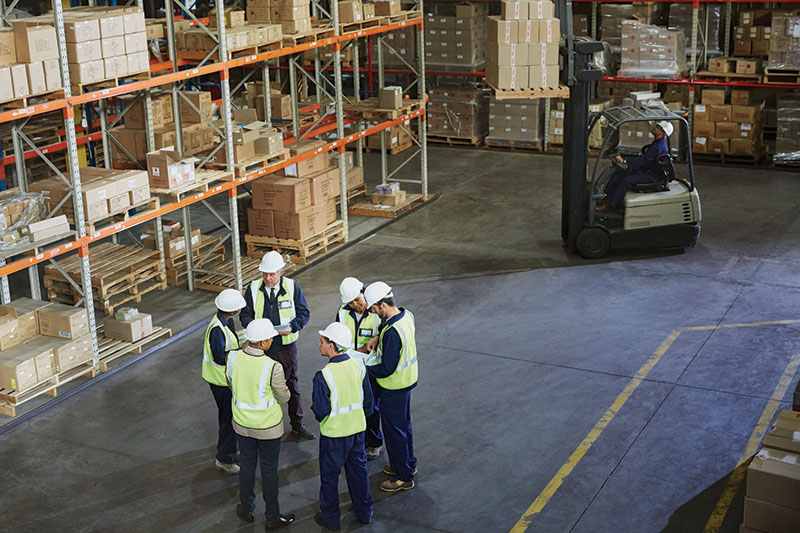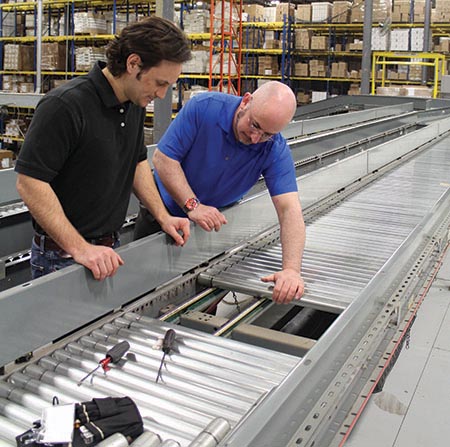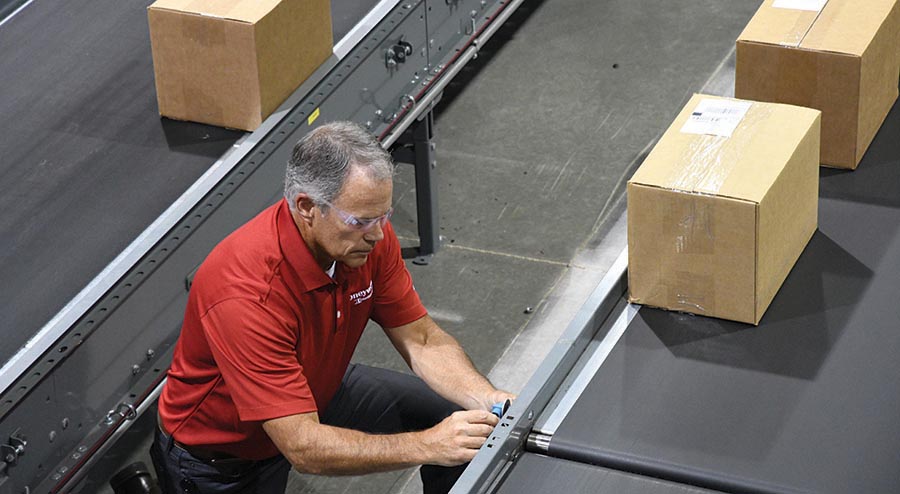Build your best warehouse maintenance team
It’s not an easy task, but it is certainly doable. Our panel of experts offers its thoughts on how to capitalize on attitude and aptitude in team members who can keep your operations up and running.

Some jobs are never done. And, maintenance is one of those jobs.
That raises an interesting question: How do you get started and build a maintenance team in the first place? Brian Poveromo has a pretty good idea of what it takes.
In early 2014, Poveromo started to build a maintenance team for a 1-million-square-foot DC that American Eagle Outfitters was building in Hazelton, Pa. When the facility opened a year later, he had nine technicians on staff.
“Finding bodies doesn’t build a team. It’s only a place to start,” says Poveromo, senior facility and maintenance manager at Hazelton. He says many of the original techs left soon after they realized American Eagle was a high-velocity facility, unlike their previous DCs. “We just weren’t the right place for them,” says Poveromo.
And high velocity still applies to Hazelton as its throughput and materials handling equipment lineup continue to expand. Today, 27 techs are on staff with plans to add nine more this year.
Building that team requires hard and soft skills. Let’s start with the soft side.
“Our techs understand first and foremost that they are the owners of this facility. And that means they have to give operations what they need,” says Poveromo. Making that happen requires the right attitude on the part of techs every day, he adds.
Other experts use similar words to describe key soft skills for technicians.
Dave Beres at Opex calls it character. Problem solvers are the words used by Scot Filgis of Dematic and James Hendrickson of Honeywell. Talk to Don Shoemaker of Synovos, and it’s clear that technicians need to be highly adaptable. Work ethic also came up multiple times in our discussions.
 All of them agree that top-grade maintenance skills are essential. “You can’t lose sight of the need for specific skill sets for technicians. The machines are not going to fix themselves,” says Shoemaker, vice president of engineering and consulting at Synovos.
All of them agree that top-grade maintenance skills are essential. “You can’t lose sight of the need for specific skill sets for technicians. The machines are not going to fix themselves,” says Shoemaker, vice president of engineering and consulting at Synovos.
That said, attitude and aptitude are not always easy to find. “With the current labor situation, it’s getting tougher and tougher to find good people day by day,” says Todd Sermersheim, Dematic’s vice president of customer service operations.
While available labor might be tight and getting tighter, building that great maintenance team is well within reach. Here are some tips.
The right soft skills
“Character is the basis for selecting a maintenance team member,” explains Beres, director of field services for warehouse automation at Opex. “Character is built on honesty, integrity, work ethic, customer service and communication,” he adds.
Or, as Poveromo says, “I don’t need technical genius. I can teach them what they need to know if they have the right attitude toward the job.”
Filgis, director of resident maintenance at Dematic, agrees that the people side is essential for a team member’s success. He identifies an ability to build excellent customer relationships as key. And the customers he’s talking about are the operations team at the facility.
“The maintenance team members have to be able to communicate effectively and interact directly with operations people. After all, the maintenance team is responsible for keeping that system running. And if it goes down, they have to be able to determine the problem quickly and do what’s necessary to ensure operations gets back on track as quickly as possible,” says Filgis.
In reality, those customer relationships are actually becoming even more important. More and more operations are already or becoming 24/7 or 22/5. That means the window for maintenance keeps getting smaller and smaller. In turn, that requires even tighter communication and coordination so maintenance of any type has the least impact possible.
“Maintenance always has to remember that lost production hours are not easily recoverable,” says Hendrickson, director of product management at Honeywell.
The hard skills
The experts tend to agree that while it’s tougher to teach soft skills they sure can teach hard skills.
“We often hire people with electrical or mechanical or software skills but they have had no exposure to materials handling equipment. That’s not a deal breaker. We can teach them that part,” explains Sermersheim.
And, teaching them those skills is very common. There are actually two paths here. One is the basic maintenance areas of expertise and the other is equipment-specific expertise.
“It is very tough to find an individual with strong electrical, mechanical and software skills. It just doesn’t happen often,” says Beres of Opex. “However, we can train them up over time where they need development. But often technicians train themselves in part with the hobbies they take on and enjoy.”
It’s worth noting that even the relative importance of the three core skills is shifting. As automation becomes more widely used, conveyors are no longer the highest level of technology in facilities. Highly automated equipment such as automated storage and retrieval systems (AS/RS) and even robotics require skills that go beyond traditional “wrench turning.” Even conveyors are more high tech than they have been in the past. Meanwhile, controls, sensors and software are taking on ever-greater importance to how equipment operates.
As Beres explains, “think about a 1980 Camaro. It had a 350-cubic-inch V8 that you could swap out yourself. Today, it’s a lot more complicated to do the same job and requires many different skills.”
That requires technicians to have higher level electrical and software skills than in the past. And when it comes to software, the ability to code is not part of the expected skill set. Instead, technicians must be able to update and otherwise upgrade software on location as needed.
Furthermore, all equipment in facilities is becoming more interconnected. “Facilities are much more data driven today and technicians need to know how to work in that world. They need to be able to get to the root cause of a problem quickly and address it,” says Beres.
Training for the job at hand
Then, there’s the matter of the equipment itself. “We know the skills that each type of equipment requires and we train techs accordingly. Some require greater software and controls skills while other equipment is heavily mechanical,” explains Sermersheim.
His colleague Filgis says that peer-to-peer training is important to team building, too. Dematic selects a tech to research a topic and present it to the team, training them in the process. “This leads to lots of discussion and sharing of ideas. Furthermore, the entire team owns the knowledge when that topic is completed,” says Filgis.
He says initial training usually runs 60 to 90 days with a combination of classroom training, e-learning and shadowing of experienced techs. “By then, we have a pretty good idea who is going to make it. It also gives us a chance to evaluate their attitude,” adds Sermersheim.
There are also different skill levels that techs can demonstrate. At Dematic, there are four levels: Tech 1,2,3, and 4.
A Tech 1 has mechanical skills for working on dock doors, lighting and the like. A Tech 2 has mechanical and electrical skills for conveyors and light automation.
A Tech 3 is proficient in electrical and controls, and a Tech 4 is controls and software. A combination can be needed for higher-end automation such as AS/RS and robotics.
American Eagle’s Poveromo goes so far as to train temps, some of who may come on as staffers if all works out well. He uses Aeroteck, the recruiting and staffing agency to find the temps. American Eagle then does the training as required.

How the game is changing
The very nature of maintenance is changing. And in some ways, the shift is already underway.
Preventive maintenance dominates today. But it is slowly being joined by predictive maintenance. While the former schedules maintenance based on anticipated equipment needs, the latter schedules maintenance only when data show it is required. And while predictive is only in its infancy, it is not a fad, says Shoemaker of Synovos.
The shift, he continues, takes much of the scheduling out of maintenance, requiring even greater communication and coordination between maintenance and operations. It also requires techs to be more efficient.
“This isn’t about reducing the size of the team but setting the stage so they can do so much more maintenance work,” explains Shoemaker. The idea is to put systems in place that get parts to techs rather than having them dig around looking for needed parts. That frees up time to actually do the maintenance work.
Getting there requires tools such as computerized maintenance management software and related systems, says Honeywell’s Hendrickson. “The idea is to make the administrative part of the job less onerous by managing parts and maintenance activities separate from the techs,” he adds.
The outcome, Shoemaker and Hendrickson agree, is technicians who are more valuable to the organization. Getting there requires both technology and
a team that works as a team rather than as a collection of individuals.
Companies mentioned in this article

Article Topics
MRO News & Resources
Avidbots showcases autonomous cleaning robots Traka exhibits modular lockers MRO Survey: Finding and keeping the best technicians Maintenance, Repair and Operations: Understanding the true condition of the equipment Newly formed Bison combines AMETEK DFS and Bison Gear and Engineering Corp. Building (and maintaining) your maintenance, repair and operations (MRO) tech workforce The power side of lift truck battery and charger maintenance More MROLatest in Materials Handling
NetLogistik partners with Vuzix subsidiary Moviynt to offer mobility solutions for warehouses Materials Handling Robotics: The new world of heterogeneous robotic integration Lucas Watson appointed CSO for Körber’s Parcel Logistics business in North America Hyster recognizes Dealers of Distinction for 2023 Carolina Handling names Joe Perkins as COO C-suite Interview with Keith Moore, CEO, AutoScheduler.AI: MODEX was a meeting place for innovation Walmart deploying autonomous lift trucks at four of its high-tech DCs More Materials HandlingSubscribe to Materials Handling Magazine

Find out what the world's most innovative companies are doing to improve productivity in their plants and distribution centers.
Start your FREE subscription today.
April 2024 Modern Materials Handling

Latest Resources










